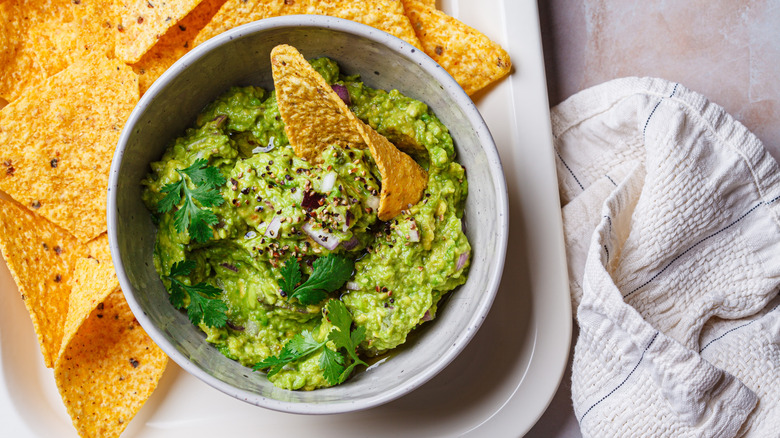The '90s Introduced America To Guacamole — The Avocado Crush That Came Before Toast
While it might seem hard to imagine these days, there was a time when guacamole wasn't the most popular dip in the America. These days, guacamole is an expectation more than it is a delicacy. Whether we're talking about the prepackaged tubs on the shelf at the grocery store, the dollop on your burrito bowl, or the classic molcajete full of the good stuff that you order at your local Mexican restaurant, guac is everywhere. So, what drove this burgeoning obsession with avocados in the United States? As it turns out, it has to do with more than just marketing campaigns and viral internet sensations. The real cause of the avocado boom in the U.S. can be chalked up in large part to the North American Free Trade Agreement, or NAFTA, which went into effect on January 1, 1994.
Now, avocados were not unknown in the United States prior to NAFTA. Recipes for dishes like avocado lime pie appeared in the 1960s, and seafood-stuffed "alligator pears" (a distinctly Southern name for avocados) date back to the 1930s in Louisiana. But before NAFTA, U.S. consumers had to rely on avocados that were either locally grown or imported from one of the smaller avocado-producing nations. You see, from 1914 to 1993, there was actually a ban on the import of Mexican avocados, meant to prevent the spread of the avocado seed weevil into U.S. crops. NAFTA put an end to that restriction and opened the borders to those favorite Mexican fruits.
Free avocado trade and the rise of guacamole
Lifting the ban on Mexican avocados did more than just give access to the world's top avocado producer, it also overcame a major hurdle for large-scale chain restaurants: seasonality. Avocados can be grown in parts of the United States, with California being the leading domestic grower, but the produce is seasonal. California avocados are only available in the spring and summer. Avocados from Mexico, on the other hand, can be had any time of year. Not only did year-round avocado availability mean that restaurants could list the menu item on a permanent basis, it also meant that guacamole would be readily available for what is likely the largest day of the year for chips and dip: the Super Bowl.
The Super Bowl is a famously gluttonous game day, with spreads of things like Buffalo wings, sliders, nachos, and, of course, chips and dip filling tables in front of the big screen. With NAFTA in place and avocados on the menu year-round, it was a natural fit for the classic Mexican dish, guacamole, to cement its position as a game day favorite.
This didn't happen all on its own — there was a big marketing push from the avocado industry in the '90s to associate watching football with the creamy green dip, but the idea quickly took hold, and shows no signs of faltering. Per capita avocado consumption in the U.S. has increased from about 1.5 pounds in the '90s to over 8 pounds in the 2020s — that's over five times as much avocado per person.
Avocados beyond the guac
Now, it's no surprise that Mexico, the world's top producer of avocados, is also responsible for the avocado's flagship dish. But there is a whole lot more that you can do with those creamy green fruits than just mash them with onion, cilantro, lime, and salt – or however you you prefer your guac. For starters, you can add some allure by grilling your guacamole avocados before use. Or, you can even add fruit for a sweet take on the classic dip.
Another interesting dish that has been growing in popularity is avocado fries. They are one of our list of unexpected foods to throw in your air fryer, and they are also a delicious new way to eat avocados. With a crisp outside and a creamy center, they're perfect for dipping in your favorite sauces — and also make an excellent taco filling. Folded up in a warm tortilla with cotija, cilantro, maybe some slaw, and a creamy sauce with a kick, you have yourself a delicious vegetarian approximation of a Baja fish taco.
But the world of avocados goes beyond Mexico and beyond savory. As with the pie recipe mentioned earlier, avocados can be the star of dessert as well. Creme de abacate (avocado cream) is a popular Brazilian dessert made with pureed avocado, dairy, sugar, and citrus. It is creamy, sweet, tangy, and rich — and an excellent way to end a meal. Clearly, so long as the United States is trading with Mexico, avocados will continue to be a significant part of the American diet. From game day spreads to the internet-popular avocado toast, we just can't seem to get enough.


